![]()
![]()
![]()
Use LEFT and RIGHT arrow keys to navigate between flashcards;
Use UP and DOWN arrow keys to flip the card;
H to show hint;
A reads text to speech;
41 Cards in this Set
- Front
- Back
|
know where the Mouth, tongue, pharynx (throat), oesophagus (food pipe), stomach, small intestine
(duodenum, ileum) and large intestine (colon, rectum) are |
diagram
|
|
|
carbohydrates are digested with ___ to form ____
|
Carbohydrates: (polysaccharides) digested with salivary amylase (to disaccharides
(eg maltose) and monosaccharides (eg glucose)) |
|
|
proteins are digested with _____ to form _____
|
Proteins: digested with pepsin, trypsin and chymotrypsin in the stomach (to polypeptides
and amino acids). |
|
|
fats are digested with ____ to form _____
|
Fats: digested with bile salts (emulsify/solubulize) and pancreatic amylase, trypsin
and lipase (to fatty acids and glycerol). Most absorption of nutrients takes place in the small intestine via the blood capillaries of villi (large surface area). |
|
|
enzymes work at different optimum pHs and body temperature (37C)
pH for stomach enxymes? pH for mouth enzymes? temp that proteins begin to denature? |
pH 2 in stomach
pH 7 in the mouth and small intestine; eg salivary amylase stops working in the stomach they begin to denature above 45 ºC) |
|
|
mucus is used for what reason and where in general?
|
The digestive tract is lubricated with mucus, which protects it from the digestive enzymes.
|
|
|
water is absorbed where?
|
Water is absorbed by the large intestine
|
|
|
ATP (Adenosine tri-phosphate) is known as
|
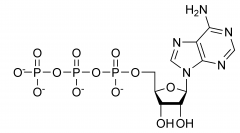
the currency of biological energy
|
|
|
ATP has 3 phosphate groups that are very important because they have
|
high energy phosphate bonds that create energy after 1 or 2 phosphates being broken off of ATP
it's a store of energy |
|
|
Glucose looks like?
How much Oxygen does one mole of glucose need for cellular respiration? |
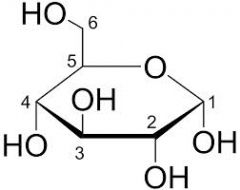
note OH group opposite O is the only one that is "up"
C6H12O6 Needs 6 O |
|
|
in cellular respiration, what are the 3 chemical pathways that are used to generate ATP/energy from glucose?
|
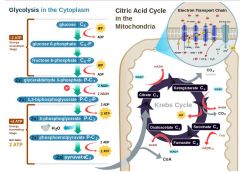
glycolysis
the citric/kreb cycle electron transport chain |
|
|
glucose and other sugars (fructose, manose, lactose) are first broken down in what biological pathways?
can non-carbohydrate/sugars use this pathway? |
gylcolysis only applies to sugars, not fats or proteins
|
|
|
glucose enters ______ and is broken down into two 3-carbon molecules called _____ and what else is generated?
|
glucose enters glycolysis and is broken down into two 3-carbon molecules called pyruvate. 2 net ATP and and 1 NADH is also generated
|
|
|
where does glycolysis occur and does it require Oxygen?
|
it occurs in the cytoplasm and does not require oxygen
It's an anerobic process |
|
|
pyruvate can go in two different directions after gylcolysis. With Oxygen, it can go to the ____
without oxygen, it can go to _____ |
pyruvate is processed by the kreb or citric cycle is arobic/needs oxygen.
if there is no oxygen, pyruvate is processed by lactic acid fermentation |
|
|
lactic acid fermentation is done for 3 reasons
|
if there isn't any oxygen, production of lactate and H+ (lactic acid) will cause the blood to become more suitable for hemoglobin to drop Oxygen
if there is a ton of pyruvate being generated even with Oxygen near by, fermentation will happen simply to deal with the amount of pyruvate. fermentation process is used to convert NADH to NAD+ which can help glycolysis keep moving |
|
|
what is the enzyme associated with the fermentation process? what are the results?
|

lactate dehydrogenase
results in lactate, NAD+, H2 molecule |
|
|
the kreb or citric acid cycle transforms pyruvate or fats or proteins in the presence of oxygen to what?
|
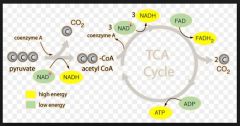
2 ATP
3 NADH FADH2 and 2 CO2 |
|
|
Where does the citric acid cycle take place?
|
inside the mitochondria
|
|
|
what is the major first step of the kreb cycle that is needed to transform pyruvate, fats, and proteins? what do these turn into?
|
they are transformed in Acetyl coA
|
|
|
after the kreb cycle, what is the last pathway?
|
electron transport chain
|
|
|
where is the electron transport chain taking place?
|
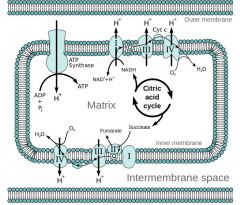
inside the mitochondrial matrix
The MATRIX. |
|
|
electron transport chain generated how many ATP?
|
30-34
|
|
|
what is glycogen? where is it primarily stored?
|
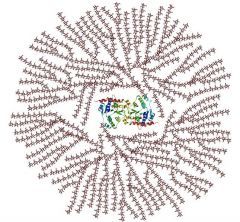
multibranched polysaccharide (meaning many sugars/carbohydrates) of glucose that serves as a form of energy storage in animals. Glycogen forms an energy reserve that can be quickly mobilized to meet a sudden need for glucose,
glycogen is made and stored primarily in the cells of the liver and the muscles, and functions as the secondary long-term energy storage |
|
|
glucose molecule numbering starts where?
|
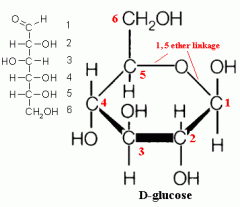
C6 H12 O6
|
|
|
glycogen is made of ____ and they are linked together in what two types of linkage system?
|
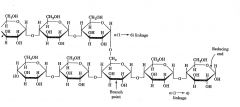
made of glucose. alpha 1, 4 and alpha 1,6
|
|
|
3 steps of cellular respiration, which require oxygen? how many ATP's produced?
|
1. glycolysis, doesnt require o2, uses 2 atp but produces 4 (2 net ATP produced)
2. krebs cycle, 2 ATP produced, requires o2 3. electron transport chain, requires o2, ~30-34 ATP produced |
|
|
Oxidation and Reduction chemistry review
OIL RIG What happens in 2H2(gas) + O2(gas)? |
OIL RIG, Oxidation is losing electrons (Oxygen or another molecule is really hogging them), Reduction is gaining electrons (reducing its charge
ie what would oxygen do to another molecule? it would steal its electrons, ie oxidation 2H2 + O2 -> 2H2O + heat (ie Blimp explosion of hydrogen gas) That O in H2O is hogging the Hydrogen electrons, leaving them each with a +1 positive charge/Oxidation State while the O has a -2 Oxidation State as it keeps those electrons closer to it most of the time So, when the H2 gas was combusted with O2, the Hydrogen atoms went from a 0 oxidation state to a +1 oxidation state, therefore the Hydrogens were OXIDIZED Likewise, the Oxygen has been REDUCED (it gained electrons, the charge was reduced) |
|
|
Biological view of Oxidation and Reduction, OIL RIG changes how from chemistry view?
Why? |
Oxidation is losing Hydrogen atoms
Reduction is gaining Hydrogen atoms (whose electron can be hogged) Biology focuses more on Hydrogen as H is swapped around with O, C, P, N, other electronegative elements as in 2H2 + O2 -> 2H2O + heat, the oxygen GAINED the hydrogen (as well as the electron), while the hydrogen LOST itself (and its electron) in a way. Normally hydrogen is just stolen from other compound in reduction. |
|
|
Simplified cellular respiration formula with glucose
ie C6H12O6 + 6O -> |
C6H12O6 + 6O -> 6CO2 + 6H2O + energy (heat + ~29-38 ATP)
|
|
|
In cellular respiration, what is oxidized? What is reduced? What isn't changed either way?
|
C6H12O6 + 6O -> 6CO2 + 6H2O + energy (heat + ~29-38 ATP)
Hydrogen remains ultimately the same as its electrons were hogged by Oxygen to begin with and are hogged in H2O afterward Carbon is oxidized as it loses its hydrogens as well as lost 24 electrons Oxygen gains those 24 electrons as well as hydrogens, so it is reduced |
|
|
Glycolysis definition
What happens w/o oxygen? How much ATP does glycolysis need? What does it do to glucose? Where does glycolysis take place? |
Breaking down of glucose
Fermentation happens w/o O2, producing lactic acid Uses 2 ATP to split the 6 Carbon backbone of glucose in two, which will also now have a phosphate group on them from the two ATP's, becoming phosphoglyceralydehyde ("investment phase") and then becoming pyruvate/pyruvic acid ("payoff phase") Takes place in cytosol/cytoplasm |
|
|
Pyruvate/pyruvic acid
|
End product of glycolysis
Glucose was split into 2 carbon chains that now bond to phosphate groups and each produce 2 ATP and creates NADH from NAD+ (add hydrogen to that) C-C-C backbone NAD+ gets reduced (gains a hydrogen) |
|
|
All the reactants needed for glycolysis and what do they produce?
|
C6H12O6 (glucose) + 2NAD+ + 2ATP + 4ADP + 2 phosphate groups
produce: 2 Pyruvates + 2 NADH + 2 ADP + 4 ATP |
|
|
Where does Krebs/citrus cycle take place?
|
INNER space of Mitochondria aka the MATRIX
|
|
|
Preparation step for Krebs cycle, what does it do? What is produced?
|
Pyruvate oxidation
Cleaves one of the Carbons off the pyruvate, now it has 2 Carbon backbone called Acetyl CoA Also reduces some NAD+ to NADH |
|
|
What (simply) happens during Krebs cycle and why is it a cycle?
How many times does it happen per glucose molecule? other reactants and products? |
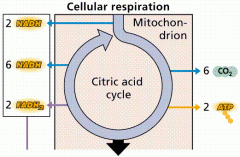
Acetyl CoA (2 carbons) reacts with Oxalocetic Acid (4 carbons) to make Citric Acid (6 carbons)
The Krebs cycle is a cycle in that it reproduces Oxalocetic acid from the Citric Acid (which also puts off CO2) The Krebs cycle happens twice for the two pyruvate molecules made from glucose During Krebs cycle, NAD+ is made into NADH and FAD is made into FADH2 as part of further ingredients for electron transport chain 2 ATP produced |
|
|
Acetyl CoA is significant to metabolizing more than just glucose how?
|
Proteins can be broken down into Acetyl CoA as well so it can enter the krebs cycle/ETC, and fats can be broken down into earlier precursors that will also become Acetyl CoA
Acetyl CoA is the common molecule that is broken down from sugars, proteins, or fats |
|
|
electron transport chain
|
produces bulk of ATP's, ~30
Have 10 NADH and 2 FADH(2) |
|
|
Oxidation of NADH in the electron transport chain and what happens afterward
|
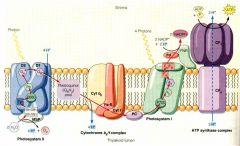
Oxidation of NADH -> NAD(+) + H(+) + 2e(-) + O (produces H2O)
-Other steps not written -Electrons release energy each step as they go from higher energy state to lower energy state -That energy is used to pump protons (Hydrogen ions) from INNER matrix into the OUTER membrane of the mitochondria -The protons are allowed back through the mitochondria membrane with a protein called ATP synthase -The H+ ions re-entering spin ATP synthase, which forces ADP and a phosphate close enough to bond |
|
|
ATP synthase
|

Protein/enzyme in the membrane of the mitochondria that allows Hydrogen ions (protons) back into the matrix after theyve been separated
The H+ spins the ATP synthase like a turbine, which pushes an ADP and phosphate close enough to bond into ATP |

